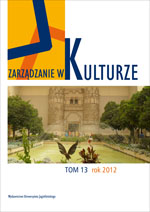E-dziedzictwo – potencjał cyfryzacji w zakresie zachowania ciągłości przekazu niematerialnego dziedzictwa kulturowego
E-heritage – the potential of digitization for the continuity of transmission of intan gible cultural heritage
Author(s): Anna GóralSubject(s): Cultural Essay, Political Essay, Societal Essay
Published by: Wydawnictwo Uniwersytetu Jagiellońskiego
Keywords: digitization; e-heritage; intangible cultural heritage; cultural heritage management
Summary/Abstract: For centuries, the cultural heritage of many generations has not always been appreciated and the access to it was limited. Many cultural goods, especially those intangible ones, were lost forever. Today, we live in an age of digital revolution. Modern IT solutions not only make it possible to preserve the achievements of generations, but also enable their wide dissemination. This is creates an opportunity to save numerous places from oblivion as well as a chance for the virtual reconstruction of historic monuments. It also allows one to preserve written works, photographs, oral history, traditions, or music. These possibilities are more and more often used by museums, which are starting to digitize their collections in order to protect and increase the availability of cultural heritage resources. This phenomenon of ever-increasing presence of museums on the Internet is referred to as cybermuseology. However, in the context of the more and more dynamic development of digital cultural resources and the growing fascination thereof, the question arises as to whether one can use the IC technology to fully present the intangible heritage without losing its cultural content and whether it is possible to retain the traditions, customs, rituals, cultural practices and human experience in a digital form. The following paper will present both opportunities and threats which digitizing carries for the intangible cultural heritage resources. The author’s reflections will be complemented by the analysis of the selected projects concerning the creation of virtual resources of intangible culture in the educational, archiving and promotional aspect.
Journal: Zarządzanie w kulturze
- Issue Year: 13/2012
- Issue No: 1
- Page Range: 87-100
- Page Count: 14
- Language: Polish

